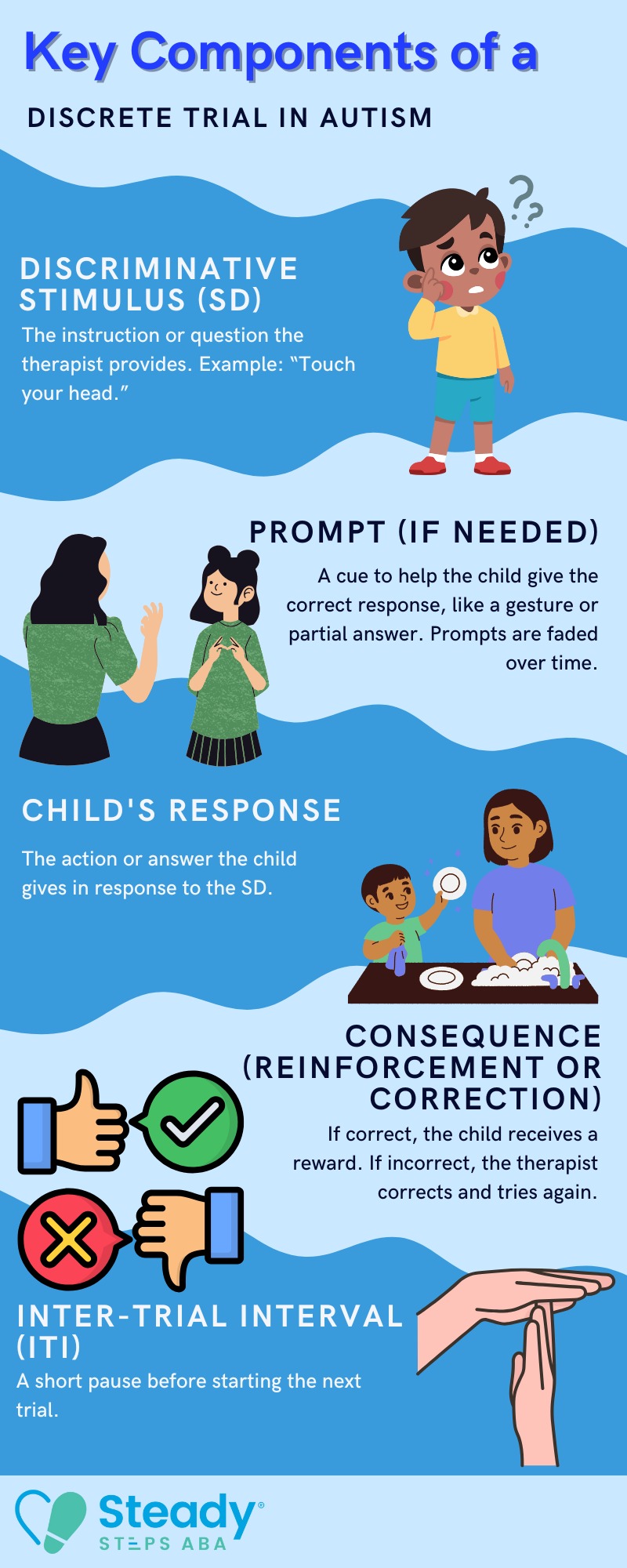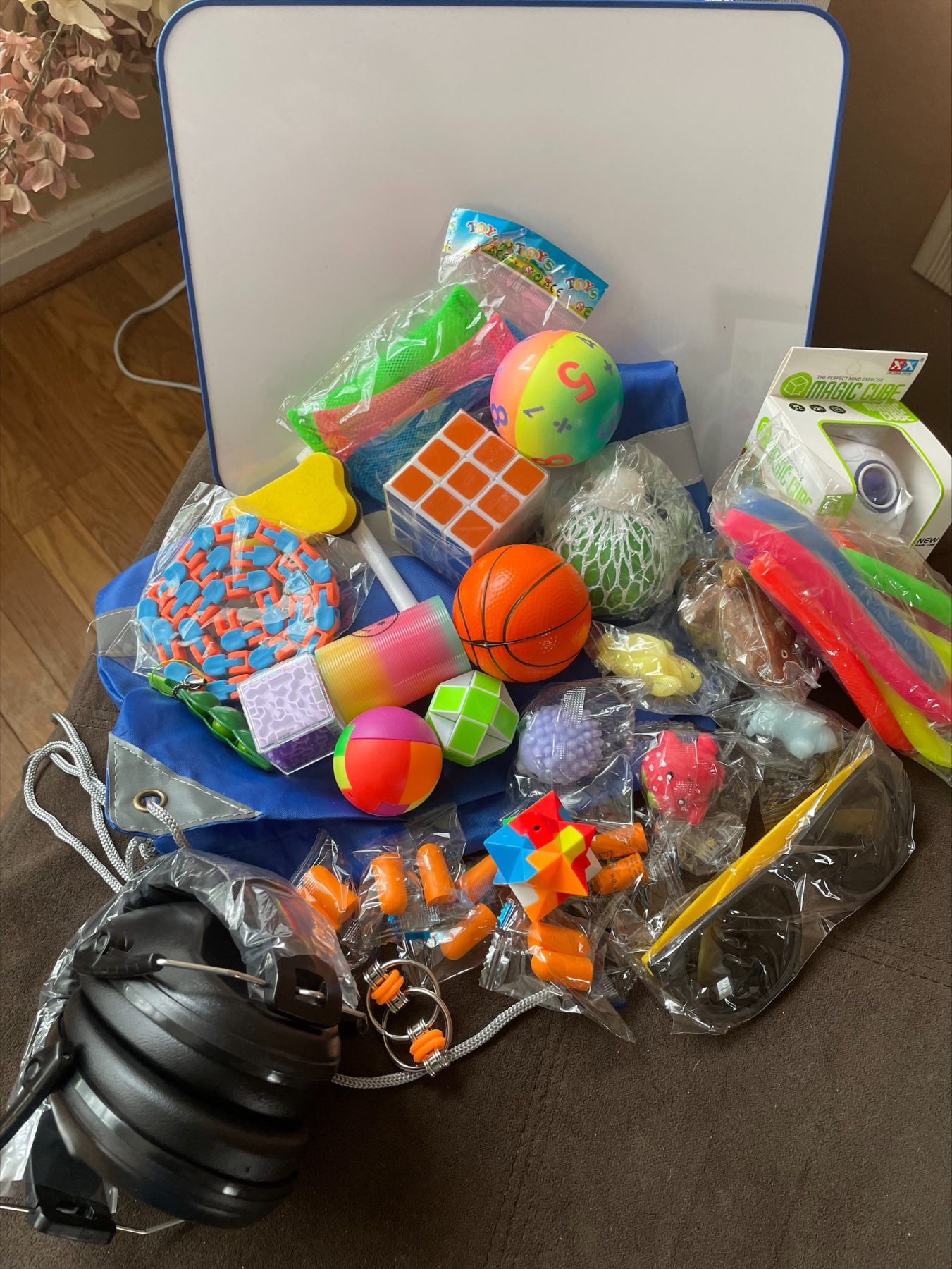Key Points:
- Discrete trial training (DTT) is an ABA method that teaches skills through repetition, reinforcement, and consistent instruction.
- It breaks down complex behaviors into small, manageable steps, ideal for early learners or children struggling with communication and focus.
- DTT is data-driven and customizable, making it adaptable to a child’s unique needs and progress.
For parents navigating autism treatment options, understanding how therapy works is essential. One approach that’s often recommended—especially in early intervention—is discrete trial training for autism.
By breaking complex behaviors into smaller tasks and reinforcing correct responses, DTT provides a clear path to skill acquisition. But for families unfamiliar with behavior therapy, it’s helpful to look at how this process actually works, what it includes, and why it matters.
What is Discrete Trial Training for Autism?
Discrete trial training for autism is a teaching method used in Applied Behavior Analysis (ABA) that involves breaking skills down into small, teachable steps. Each step is taught individually using clear instructions, prompts, and consistent reinforcement.
DTT focuses on teaching specific behaviors or skills through repeated practice. For example, if the goal is to teach a child to identify colors, the therapist might present a red block and say, “What color?” If the child responds with “red,” they are immediately reinforced—either with praise or something motivating, like a toy or snack. If not, prompting or correction is used to guide them toward the right answer.
Each of these interactions is called a trial and consists of three parts: the instruction (or SD, discriminative stimulus), the child’s response, and the consequence. This format makes learning predictable, and over time, children gain mastery and fluency in various skills.
Why is DTT Effective for Children with Autism?
Many children with autism benefit from consistency, repetition, and structure—all central to DTT. Traditional learning environments can be overwhelming or unclear for children with communication or attention challenges. DTT provides a clear, simplified learning format with frequent reinforcement, which helps keep them engaged and progressing.
This method is particularly effective for teaching early learners skills that they may not acquire naturally, such as:
- Imitating actions
- Matching objects
- Understanding instructions
- Learning basic self-care
- Building vocabulary and speech
Because each trial is short and focused, DTT is ideal for targeting specific learning goals while minimizing distractions.
What are the Key Components of a Discrete Trial?
Understanding how each discrete trial works helps parents follow along with therapy and even reinforce learning at home. Each trial follows a clear, consistent structure designed to increase the child’s chances of success.
Each discrete trial includes:

When these parts are consistently applied, the child learns what’s expected, how to respond, and what outcomes follow.
What Types of Skills Can Be Taught Using DTT?
Discrete Trial Training (DTT) is used to teach a wide range of skills through structured, step-by-step instruction. Common areas include language development, social interaction, academic skills, and self-care routines. For example, children can learn to identify objects, follow directions, count, or brush their teeth using DTT methods.
Each skill is broken down into small, manageable parts with prompts and reinforcement provided throughout the learning process. DTT is especially effective for individuals with autism because it offers clear expectations, immediate feedback, and consistent repetition. Therapists often track data to measure progress and adapt instruction based on individual needs. This structured and personalized approach also supports the development of more complex social-emotional skills—such as understanding others’ perspectives—which is explored further in Teaching Empathy in Autism: Where to Start and What Works.
How is DTT Different From Other ABA Techniques?
ABA includes a range of strategies, and while DTT is one of the most widely used, it isn’t the only method. Parents often hear about other approaches like natural environment teaching (NET) or incidental teaching—so what sets DTT apart?
DTT is:
- Highly structured: Conducted at a table or designated work area.
- Adult-led: The therapist controls the learning trials.
- Focused on isolated skills: Each task is taught individually.
- Repetition-based: Trials are repeated until the skill is mastered.
- Data-driven: Every response is recorded to track progress.
In contrast, naturalistic teaching occurs in more informal, play-based settings and uses the child’s interests to prompt learning opportunities. Many ABA programs combine both to give children a more comprehensive learning experience.
What Does a Typical DTT Session Look Like?
A typical Discrete Trial Training (DTT) session involves structured, one-on-one instruction broken into clear, repeatable steps. Each trial includes an instruction (e.g., “Touch the ball”), the child’s response, and a consequence, such as praise or a tangible reward for correct answers. If the child makes an error, the therapist provides a prompt and allows another attempt.
Sessions usually last 5 to 20 minutes per target skill and are repeated frequently to build fluency and retention. Therapists collect data throughout to track progress and adjust teaching strategies. This predictable, consistent format helps learners build confidence and master new skills efficiently.

How Do Therapists Measure Progress in DTT?
One of the reasons DTT is so effective is its emphasis on measurable outcomes. Data is collected during every session to track how many correct responses a child makes, how much prompting is required, and whether behaviors are improving over time.
Progress is tracked through:
- Trial-by-trial data sheets
- Prompt-level documentation
- Percentage of independence
- Error correction trends
- Generalization records (how well the child uses the skill in new settings)
This data allows therapists to make informed decisions—whether that means moving to more advanced goals, trying new prompts, or adjusting reinforcement.
What are the Limitations of DTT?
While effective, DTT can become monotonous if overused or not paired with more naturalistic methods. It may also limit a child’s ability to generalize skills to real-life settings unless explicitly programmed for. Moreover, it demands consistency and skilled delivery, which can be resource-intensive for families and providers.
For the best outcomes, DTT is often integrated with other ABA methods like Natural Environment Teaching (NET) and play-based interventions, creating a more balanced, engaging, and functional learning experience.
How Can Parents Support Discrete Trial Learning at Home?
Even if DTT sessions are run by therapists, parental involvement is crucial. Practicing skills at home helps children retain what they’ve learned and apply it outside of structured sessions.
Here are ways parents can support DTT principles at home:
1. Reinforce Learned Skills
During daily routines—like meals or getting dressed—ask your child to follow simple directions or label familiar items. This strengthens recall in natural settings.
2. Use Consistent Language
Repeating the same prompts and cues used by your child’s therapist helps avoid confusion and increases the likelihood of correct responses.
3. Celebrate Effort
Offer praise, stickers, or small rewards to positively reinforce attempts and correct answers. This boosts motivation and reinforces learning.
4. Practice Generalization
Try using skills in new places or with different family members to help your child apply what they’ve learned beyond the therapy setting.
5. Stay Connected with the Therapy Team
Regularly update your ABA provider on progress and challenges. Ask for home-friendly activities that align with ongoing DTT goals.
Consistency between therapy and home creates a strong, supportive learning environment that accelerates growth.
Invest in Lifelong Success with ABA Therapy
If you’re a parent looking for a structured, proven approach to help your child with autism build essential skills, Steady Steps ABA provides individualized ABA therapy in Maryland that includes effective discrete trial training for autism.
Our team uses data-backed methods tailored to your child’s unique learning style and developmental goals. Whether you’re just starting out or looking to build on existing skills, we’re here to support meaningful, long-term progress.
Contact us today to learn more about ABA therapy in Maryland and discover how structured strategies like DTT can make a lasting difference in your child’s life.






